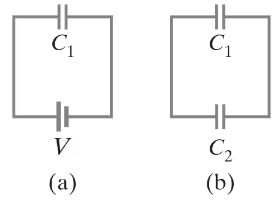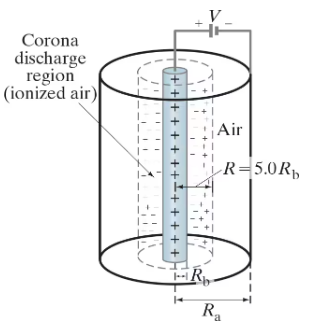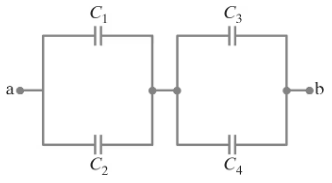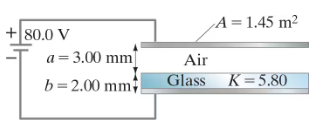 Back
Back Giancoli Douglas 5th edition
Giancoli Douglas 5th edition Ch. 24 - Capacitance, Dielectrics, Electric Energy, Storage
Ch. 24 - Capacitance, Dielectrics, Electric Energy, Storage Problem 6
(II) A 7.7-μF capacitor is charged by a 185-V battery (Fig. 24–21a) and then is disconnected from the battery. When this capacitor (C₁) is then connected (Fig. 24–21b) to a second (initially uncharged) capacitor, C₂, the final voltage on each capacitor is 15 V. What is the value of C₂? [Hint: Charge is conserved.]
Problem 13
To get an idea how big a farad is, suppose you want to make a 1-F air-filled parallel-plate capacitor for a circuit you are building. To make it a reasonable size, suppose you limit the plate area to 1.0 cm². What would the gap have to be between the plates? Is this practically achievable?
Problem 19b
Small distances can be measured using a capacitor whose plate separation 𝓍 is variable. Consider an air-filled parallel-plate capacitor with fixed plate area A = 25 mm² separated by a variable distance 𝓍. Assume this capacitor is attached to a capacitance-measuring instrument which can measure capacitance C in the range 1.0 pF to 1000.0 pF with an accuracy of ∆C = 0.1 pF. Define ∆𝓍 to be the accuracy (magnitude) to which 𝓍 can be determined, and determine a formula for ∆𝓍.
Problem 20
In an electrostatic air cleaner (“precipitator”), the strong nonuniform electric field in the central region of a cylindrical capacitor (with outer and inner cylindrical radii Rₐ and R₆ ) is used to create ionized air molecules for use in charging dust and soot particles (Fig. 24–22). Under standard atmospheric conditions, if air is subjected to an electric field magnitude that exceeds its dielectric strength Eₛ ≈ 3.0 x 10⁶ N/C, air molecules will dissociate into positively charged ions and free electrons. In a precipitator, the region within which air is ionized (the corona discharge region) occupies a cylindrical volume of radius R that is typically five times that of the inner cylinder. Assume a particular precipitator is constructed with R₆ = 0.10 mm and Rₐ = 10.0 cm. In order to create a corona discharge region with radius R = 5.0 R₆, what potential difference V should be applied between the precipitator’s inner and outer conducting cylinders? [Besides dissociating air, the charged inner cylinder repels the resulting positive ions from the corona discharge region, where they are put to use in charging dust particles, which are then “collected” on the negatively charged outer cylinder.]
Problem 34c
Suppose in Fig. 24–27 that C₁ = C₃ = 8.0μF, C₂ = C₄ = 16μF, and Q₃ = 21μC. Determine the voltage Vba across the combination.
Problem 36
Two capacitors connected in parallel produce an equivalent capacitance of 32.9-μF, but when connected in series the equivalent capacitance is only 5.5 μF. What is the individual capacitance of each capacitor?
Problem 50a
A cylindrical capacitor (Example 24–2) has Rₐ = 3.5 mm and R₆.= 0.50 mm. The two conductors have a potential difference of 625 V, with the inner conductor at the higher potential. Calculate the energy stored in a 1.0-m length of the capacitor.
Problem 53
What is the capacitance of a pair of circular plates with a radius of 5.0 cm separated by 2.3 mm of mica?
Problem 57
A 3500-pF air-gap capacitor is connected to an 18-V battery. If a piece of mica fills the space between the plates, how much charge will flow from the battery?
Problem 70
The capacitor shown in Fig. 24–34 is connected to an 80.0-V battery. Calculate (and sketch) the electric field everywhere between the capacitor plates. Find both the free charge on each capacitor plate and the induced charge on the faces of the glass dielectric plate.
Problem 84
A parallel-plate capacitor has square plates 12 cm on a side separated by 0.10 mm of plastic with a dielectric constant of K = 3.8. The plates are connected to a battery, causing them to become oppositely charged. Since the oppositely charged plates attract each other, they exert a pressure on the dielectric. If this pressure is 40.0 Pa, what is the battery voltage?
Problem 85a
A parallel-plate capacitor with plate area 2.0 cm² and air-gap separation 0.50 mm is connected to a 12-V battery, and fully charged. The battery is then disconnected. What is the charge on the capacitor?
Problem 85b
A parallel-plate capacitor with plate area 2.0 cm² and air-gap separation 0.50 mm is connected to a 12-V battery, and fully charged. The battery is then disconnected. The plates are now pulled to a separation of 0.85 mm. What is the charge on the capacitor now?
Problem 95
Capacitors can be used as “electric charge counters.” Consider an initially uncharged capacitor of capacitance C with its bottom plate grounded and its top plate connected to a source of electrons. If N electrons flow onto the capacitor’s top plate, show that the resulting potential difference V across the capacitor is directly proportional to N.
Problem 98a
In lightning storms, the potential difference between the Earth and the bottom of the thunderclouds can be as high as 35,000,000 V. The bottoms of thunderclouds are typically 1500 m above the Earth, and can have an area of 110 km². Modeling the Earth–cloud system as a huge capacitor, calculate the capacitance of the Earth–cloud system,



